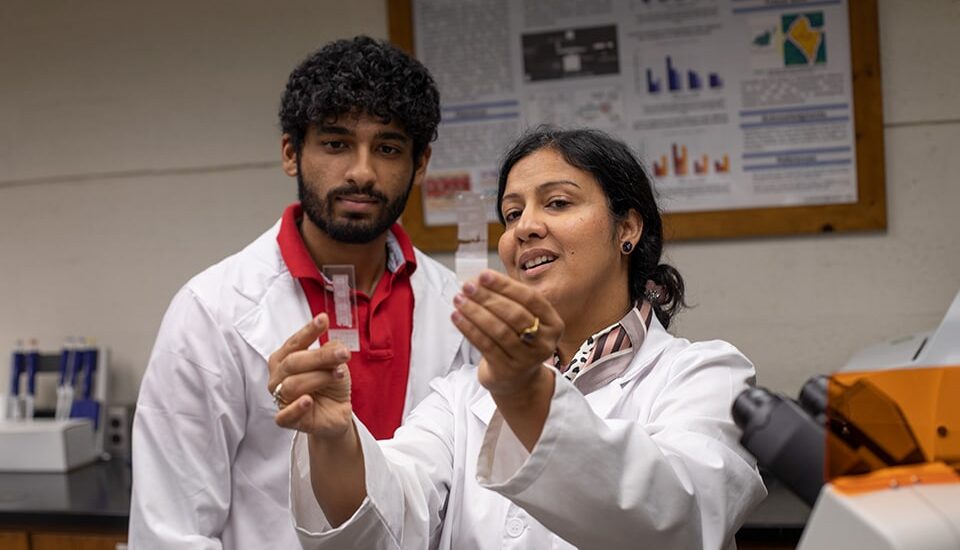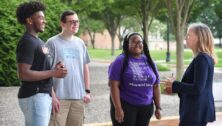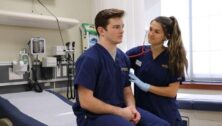Undergraduates Work with Widener Professor to Research a Birth Injury

A unique research program for undergraduate and graduate students at Widener University in Chester is helping bioengineering professor Dr. Anita Singh study, diagnose, and treat a childbirth injury that can lead to loss of movement or weakness in the upper extremities of a newborn.
The injury is known as neonatal brachial plexus palsy or NBPP and it results from an overstretching of the brachial plexus nerves, which provide feeling and muscle control for the shoulder, arm, hand, and fingers.
The injury occurs in one to four out of every 1,000 births worldwide.
Adjunct Associate Professor Anita Singh of Widener’s bioengineering department has been researching the condition with the help of university undergrads.
Anita Singh recently received a five-year $1.9 million grant from the National Institutes of Health to expand the research and develop strategies for the prevention and treatment of the injury. It is one of the largest awards ever received by a Widener faculty member.
“What is so unique about Widener is that our undergraduates are so heavily involved in research and grants, such as this one, which allows me to engage with students further,” said Singh. “This grant would not work without our students.”
The undergraduates initially started working in Singh’s lab during the university’s Summer Undergraduate Research and Creative Activities program.
Zaph Joseph, a Widener senior from Downingtown, is one of the newest undergraduate researchers to join the lab. The psychology major is enrolled in Widener’s physical therapy program and is exploring the complexities of human biomechanics.
“Research was something I was always curious about,” Joseph said. “For me, I really wanted to do something along the lines of biomechanics,” he said.
To him, the most interesting research dealt with the central nervous system and spinal cord injuries.
“When I saw Dr. Singh’s work, I thought it was kind of a no-brainer to ask to work with her over the summer.”
Dr. Anita Singh’s research can be demanding. She utilizes three or four students at a time in her lab, with some staying for more than three years. Over time, she estimates she’s worked with more than 40 undergraduate researchers.
“The biggest advantage I can see with undergrads is the fresh mindset they bring in and the enthusiasm that they come in with,” Dr. Singh said.
She greatly appreciates their commitment to the research as the students balance classes, homework, exams, and outside interests with the lab work.
“I’ve had Zaph on I don’t know how many different projects. He’s got tissue for me, he’s taking images for me, his willingness to say ‘Sure, Dr. Singh, I’ll do that.’”
The students will often arrive at the lab at 4 PM and still be on the job at 2 AM, Dr. Singh said.
Joseph said he was surprised at how much he enjoyed the work, so much so that he is now shifting his career plans in line with the birth injury research.
The Research
Singh is using her research to find an effective means of diagnosing NBPP early and preventing the injury with lifestyle changes, or by allowing a clinical intervention if the potential for the injury is discovered, as well as new treatments after the injury occurs.
As Dr. Singh works internally with Widener students and staff, she’s also collaborating with national experts, including teams in Texas at UT Health Austin and at Drexel University.
She became interested in the research in 2015 during an OBGYN symposium at Wayne State University in Detroit. During discussions, her work on lower spine injuries was referenced and they asked her if the research could be applied to the upper spine region since they didn’t know how brachial plexus neck injuries were occurring in childbirth.
A main cause of NBPP injury results from obesity in the mother and gestational diabetes. In these cases, the bone and skeletal structure of the mother remains the same, but when gestational obesity or diabetes sets in, the baby ends up being bigger than normal in a small pelvic area. The baby’s shoulder can get stuck behind the mom’s pelvis, triggering the injury.
“At the moment we are trying to create computational tools that can be used by clinicians to really replicate a simulation of a baby inside the mom’s pelvis and base positions,” Dr. Singh said.
The tool can simulate the conditions that stretch the brachial plexus and cause injury.
Part of Joseph’s work is to look at what other researchers have done on the topic.
“It’s interesting to see that things like this have not been very well done,” he said. “It just shows how revolutionary Dr. Singh’s work really is. It’s awe-inspiring to see that.”
Connect With Your Community
Subscribe to stay informed!
"*" indicates required fields










![95000-1023_ACJ_BannerAd[1]](https://vista.today/wp-content/uploads/2023/03/95000-1023_ACJ_BannerAd1.jpg)






































